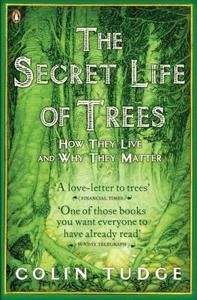The Secret Life of Trees
How They Live and Why They Matter

Editorial Penguin UK
Fecha de edición julio 2006
Idioma inglés
EAN 9780141012933
464 páginas
Libro
encuadernado en tapa blanda
Resumen del libro
What is a tree? As this celebration of the trees shows, they are our countryside; our ancestors descended from them; they gave us air to breathe. Yet while the stories of trees are as plentiful as leaves in a forest, they are rarely told. Here, Colin Tudge travels from his own back garden round the world to explore the beauty, variety and ingenuity of trees everywhere: from how they live so long to how they talk to each other and why they came to exist in the first place. Lyrical and evocative, this book will make everyone fall in love with the trees around them.
Extract from The Secret Life of Trees by Colin Tudge
WHAT IS A TREE?
A tree is a big plant with a stick up the middle.
Everybody knows that. But that statement as it stands requires what modern philosophers would call a little 'deconstruction'.
What, for a start, is meant by 'big'? It's a relative term of course, although if we choose we can put a figure on it - say a minimum height of five or six metres. There is a case for doing this: if you are a forester, or are running a nursery, you need some guidelines. But guidelines are not definitions. They are ways of helping practical people to do practical things. They do not - and are not intended to - capture what Aristotle would have called the essence of nature.
For many trees grow big when conditions are favourable, and stay small when they are not. An oak is a noble tree in a forest or a park but an acorn that falls in a fissure in some Scottish crag may spend a couple of centuries in bonsaid mode, never more than a twisted stick. Yet it may turn out acorns which, if they should be carried to some fertile field, could again produce magnificence. Is the twisted stick less of an oak because it fell on stony ground? And if it remains an oak, is it not still a tree? Or then again - a different kind of case - the world's many kind of birch form the genus Betula. None are as huge as an oak may sometimes be, but most are perfectly respectable trees. Yet there is one, Betula nana, that is adapted to the tundra of the north of Scotland and mainland Europe and is very small indeed. Do we say that all birches are trees except for the tough little Betula nana? Or do we say it's a dwarf tree?
What of the stick that runs up the middle, the 'trunk', that holds the 'crown' of the tree aloft? Should there be just one, a solitary pillar, or are several allowed? Many a gardener and forester has insisted that plants with a lot of supporting sticks should be called shrubs. Again, for practical purposes such distinctions can be useful. If Alice's Queen of Hearts had instructed her long-suffering gardeners to plant her an arboretum and they'd come up with a shrubbery, their heads would surely have come off. But wild nature is not so easily pinned down. In the Cerrado of Brazil - the vast dry forest, about the size of France, in the middle of the country to the south and east of Amazonia's rainforest - there are trees that form bona fide, big, one-trunked trees when they grow along the banks of the occasional rivers, but become multi-stemmed, short shrubs where it's drier. The shrub is not merely stunted, like the oak in the rock. It is a discrete life form. Many organisms exhibit what biologists call 'polymorphism', meaning 'many forms'. Many kinds of fish, for example, have dwarf forms and full-size forms; some butterflies and snails are highly variable. Here we see a polymorphic tree - one form for the forest, another for the open ground.
Then again many big trees including some cedars, many a mulberry, or the beautiful blue-flowered jacaranda, may grow from ground level with several solid trunks of equal magnitude. Each may be as big as a respectable oak. Are they trees, or big shrubs? The family of the heathers, Ericaceae, also includes the rhododendrons from the Himalayas, and the beautiful flaky, yellow/pink/grey-trunked madrone trees of the United States (which add yet more colour to the already wondrous hills of California). Rhododendrons tend to have many stems while madrones are commonly content with one. But the rhododendrons can be just as big and solidly wooden as the madrones. In nature, in short, trees and shrubs are not distinct. Why should they be? Nature was not designed to make life easy for biologists.
Must the central stick be of wood? That, after all, is what we generally mean by 'stick'. How, then, should we categorize banana plants? In general shape they resemble palm trees, with a thick central stem and a whorl of huge leaves at the top. But the stem of the banana plant is not of wood. Its stem is formed largely from the stalks of the leaves, and its strength comes from fibres which are not bound together as in pines or oaks or eucalypts to form true timber; its hardness is reinforced, as in a cabbage stalk, by the pressure of water in the stem. So botanically the banana plant is a giant herb. But it looks like a tree and competes with trees on their own terms, as a big plant seeking the light (although like the trees of cocoa and tea and coffee, the banana prefers a little shade).
In fact there are many lineages of plants - quite separate evolutionary lines that have nothing to do with each other except that they are all plants. Many plants, in many of those lineages, have independently essayed the form of the tree. Each achieves freedom in its own way. 'Tree' is not a distinct category, like 'dog' or 'horse'. It is just a way of being a plant. The different kinds have much in common and it is good and necessary to have some feel for what is essential. But the essences of nature will not be pinned down easily. In the end, all definitions of nature are simply for convenience, helping us to focus on the particular aspect that we happen to be thinking about at the time. There is no phenomenon in all of nature - whether it's as simple as 'leg' or 'stomach' or 'leaf' or more obviously conceptual like 'gene' or 'species' - that does not take a variety of forms, and which cannot be looked at from an infinite number of angles; and each angle gives rise to its own definition. A horse cannot be encapsulated as Charles Dickens' Thomas Gradgrind insisted in Hard Times as 'A graminivorous quadruped'. There is more to horses than that. The way we define natural things influences the way we treat them - whether we speak of wild flowers or of weeds, of Mrs Tittlemouse or of vermin. But in the end nature is as nature is, and we must just try with different degrees of feebleness, and for our own purposes, to make what sense of it we can.
At Boscobel in Shropshire in the English Midlands stands the Royal Oak, where the provisional King Charles II is alleged to have hidden from Cromwell's men after the Battle of Worcester. And why not? All this happened only about three and a half centuries ago (1651) and oaks may live for two or three times as long as that. A yew I met in a churchyard in Scotland has a label suggesting that the young Pontius Pilate may once have sat in its shade - and wondered what the future held . Conceivably: at about the time that Jesus was born Pilate's father was a soldier in those parts - and by then that yew was already mature.
Many a redwood still standing tall in California was ancient by the time Columbus first made Europe aware that the Americas exist. And some of California's pines germinated at about the time that human beings invented writing and so are as old as all of written history. Some living trees have seen the rise and fall of entire civilisations.
Some redwoods and Douglas firs and eucalypts are as tall as a perfectly respectable skyscraper, and there's an extraordinary banyan in Calcutta that would cover a football field. Many are host to so many other creatures that each is a city: as cosmopolitan as Delhi or New York and far more populous than either. When the Amazon is in flood - deep enough to submerge well-grown trees entirely - the fish feed on fruit, and the river dolphins race through the upper branches of what should be the canopy. I once found myself in an old kapok tree in Costa Rica in which biologists had thus far listed more that 4000 different species of other creatures.
Yet a tree cannot afford simply to serve as someone else's monument and feeding ground. From the moment the seed falls on to the forest floor (or the sand of the savannah, or a fissure in some mountain crag, or a glacier's edge or a lakeside or a tropical seashore) to the moment of its final demise, perhaps a thousand years later, the tree must fight its corner, a creature like all the rest.
The human debt to trees is absolute. Our ancestors, somewhere in Africa, came to the ground when the climate dried up and the trees retreated. Archaeologists speak of the stone ages, and the bronze age, the iron age and the steam age, and now we have the age of nuclear power and space and IT. But every age has been a wood age - ours at least as much as any in the past; and perhaps, in the decades to come, even more so.
Yet timber is not the end of it. Trees are the source of drugs and unguents and incense and poisons, of resins and varnishes and industrial oils, glues and dyes and paints, gums of many kinds including chewing gum, a host of fibres - and of course, perhaps above all these days, for paper. All that, plus a thousand (at least) kinds of fruits and nuts and a surprising amount of fodder for animals. As a final bonus, the wooden husks of many a fruit make instant household pots and drums and ornaments. In short, without trees, our species would not have come into being at all.
This book is mainly about the science of trees. The last chapter is about the uses we make of them, and what they do for us, and why for reasons that are purely material they must be conserved: our survival depends on them. But most of this book is not about their usefulness, but about what they are: how they came into being; what kinds there are and where they live and why; how they live, competing and co-operating. The more we know about them, the more trees seem like the key to the world's survival.








